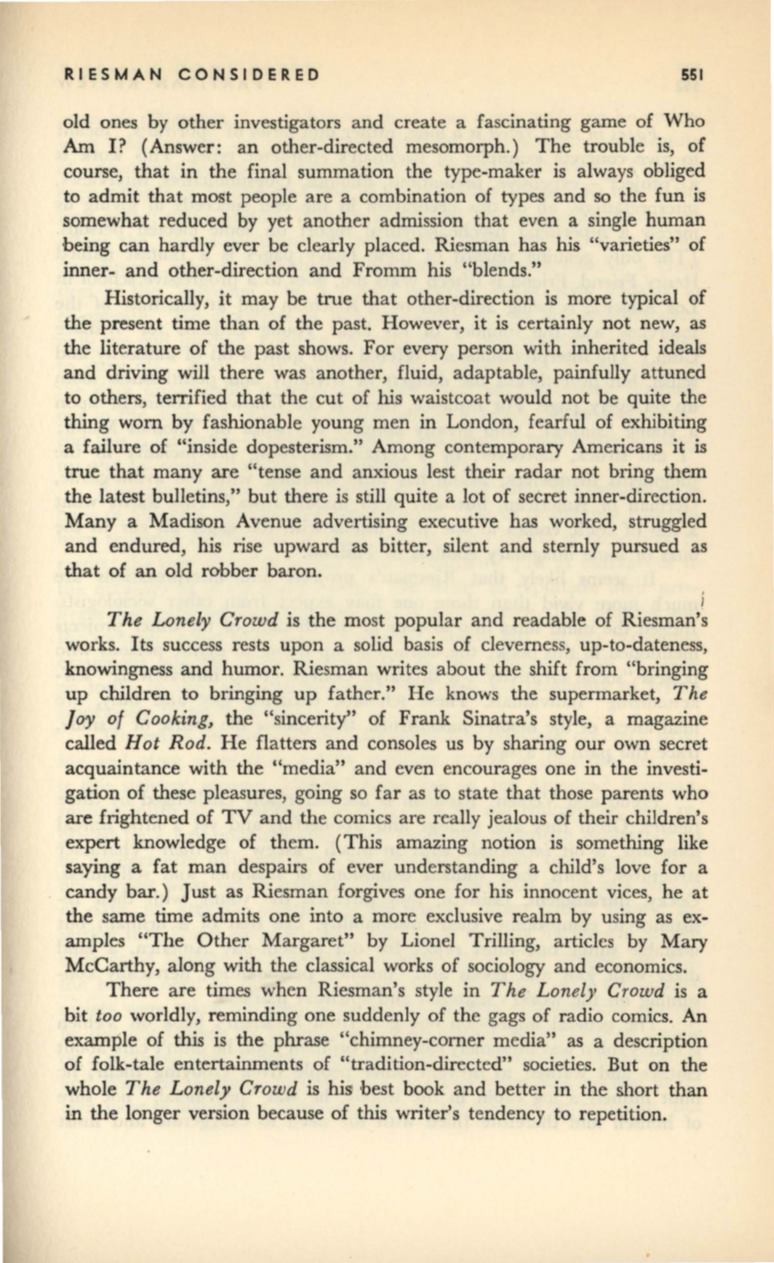
RIESMAN CONSIDERED
551
old ones by other investigators and create a fascinating game of Who
Am
I? (Answer: an other-directed mesomorph.) The trouble is, of
course, that in the final summation the type-maker is always obliged
to admit that most people are a combination of types and so the fun is
somewhat reduced by yet another admission that even a single human
being can hardly ever be clearly placed. Riesman has his "varieties" of
inner- and other-direction and Fromm his "blends."
Historically, it may be true that other-direction is more typical of
the present time than of the past. However, it is certainly not new, as
the literature of the past shows. For every person with inherited ideals
and driving will there was another, fluid, adaptable, painfully attuned
to others, terrified that the cut of his waistcoat would not be quite the
thing worn by fashionable young men in London, fearful of exhibiting
a failure of "inside dopesterism." Among contemporary Americans it is
true that many are "tense and anxious lest their radar not bring them
the latest bulletins," but there is still quite a lot of secret inner-direction.
Many a Madison Avenue advertising executive has worked, struggled
and endured, his rise upward as bitter, silent and sternly pursued as
that of an old robber baron.
i
The Lonely Crowd
is the most popular and readable of Riesman's
works. Its success rests upon a solid basis of cleverness, up-to-dateness,
knowingness and humor. Riesman writes about the shift from "bringing
up children to bringing up father." He knows the supermarket,
The
Joy of Cooking,
the "sincerity" of Frank Sinatra's style, a magazine
called
Hot Rod.
He flatters and consoles us by sharing our own secret
acquaintance with the "media" and even encourages one in the investi–
gation of these pleasures, going so far as to state that those parents who
are frightened of TV and the comics are really jealous of their children's
expert knowledge of them. (This amazing notion is something like
saying a fat man despairs of ever understanding a child's love for a
candy bar.) Just as Riesman forgives one for his innocent vices, he at
the same time admits one into a more exclusive realm by using as ex–
amples "The Other Margaret" by Lionel Trilling, articles by Mary
McCarthy, along with the classical works of sociology and economics.
There are times when Riesman's style in
The Lonely Crowd
is a
bit
too
worldly, reminding one suddenly of the gags of radio comics. An
example of this is the phrase "chimney-comer media" as a description
of folk-tale entertainments of "tradition-directed" societies. But on the
whole
The Lonely Crowd
is his best book and better in the short than
in the longer version because of this writer's tendency to repetition.


